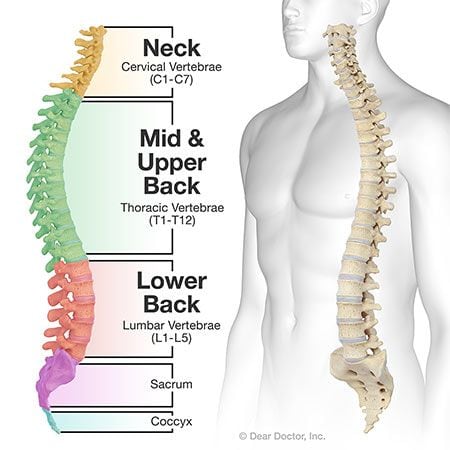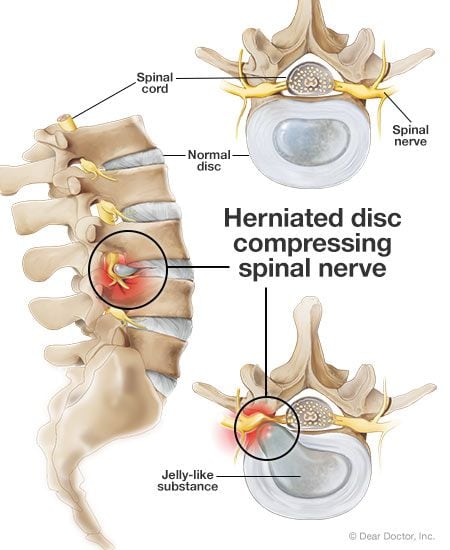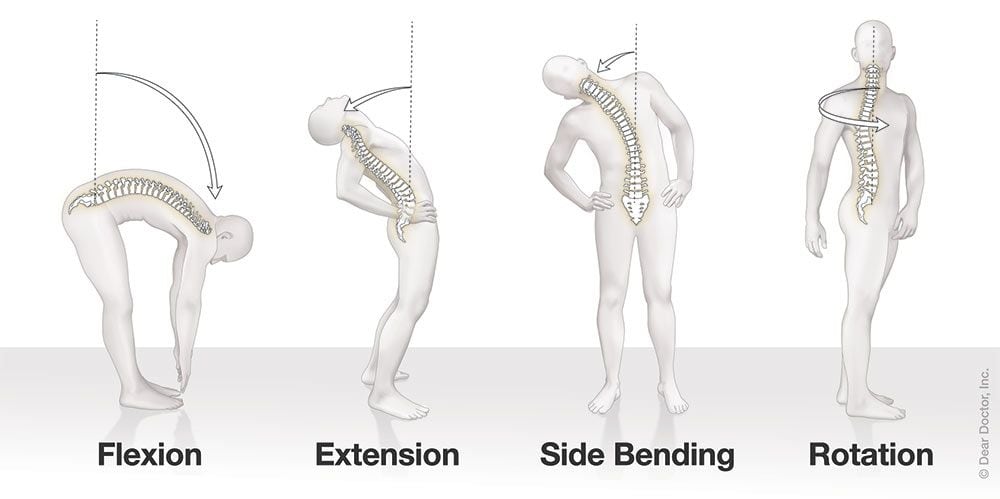How does the Spine work?
Our spine and the spinal cord it protects form the basis of our body’s structure and ability to function. When our “backbone” is strong and working well, we are able to do anything from routine activities to stunning feats of athletic prowess. When something is amiss, it can make it hard or impossible to go about our daily activities. Understanding the spine and how to maintain it goes a long way toward keeping us healthy and moving well our whole lives.
Just as dentists specialize in teeth and cardiologists focus on the cardiovascular system, chiropractors are trained in biomechanics and anatomy with an emphasis on the spine. Here’s an overview of this impressive part of the human body.
The Spinal Cord
The spinal cord is a cylindrical bundle of millions of nerve fibers within our spine that runs the length of our spinal column. Along with the brain, the spinal cord makes up the central nervous system, our command and control center. The spinal cord transmits nerve signals from the brain that enable our motor functions and sends signals from the body to the brain for interpretation, including sensations from a tickle to pain.
The Spinal Column and Vertebrae
The spine is a column of 26 bony segments, called vertebrae. It does double duty: Not only does it protect the spinal cord, but it also creates a flexible framework that allows us to sit, stand, bend, reach, and more. When the spine’s flexibility is damaged by injury, disease, disease, or age, you can develop back, neck, or other pain. You may also have limited function.
The normal spine has an "S"-like curve that allows our weight to be evenly distributed and withstand stress. The curves of the “S” provide balance and flexibility as well as each being a counterweight to the other.
The top of the “S” is formed by 7 cervical (neck) vertebrae that curve inward. This part of the spine can be injured by strong sudden movements such as whiplash because it has limited muscles to support the weight of the head—an evolutionary trade-off for flexibility.
The cervical spine is followed by an outward curve of the next 12 vertebrae, called the thoracic spine (the mid and upper back). The thoracic spine connects to the ribs, so this part of the spine is less mobile in comparison to other parts of the spine.
The lower back vertebrae—the lumbar region—curve inward again. This section of the spine bears most of your weight, which is why low back pain is so common. Most people have five lumbar vertebrae, but about 10% of us have six!
Below the lumbar spine is the pelvis, which consists of the coccyx, the sacrum, and the hip bones. These work together to bear weight and are needed for walking, standing, and sitting.
The curves of the spine are essential for overall well-being but are also crucial for proper balance and minimizing your chances of neck and back injury or pain in the future. Having a good, banana-shaped curve is ideal. Many chiropractors can analyze these curves to assess your risk for injury or disease of the spine. Abnormal curvature has many causes. A person can develop scoliosis (a sideways curve) during early development, and it is also possible to distort your ideal curves from poor posture or poor technology use habits.
Discs and Vertebral Openings
The vertebrae are connected by “intervertebral joints,” which are two adjacent vertebrae with a disc—a soft, rounded pad—in between them. When we examine a patient, we pay close attention to these joints to make sure they are aligned and mobile.
The discs, which are about half an inch thick, cushion the vertebrae, acting as shock absorbers that allow the spine to bend and twist. Discs are made up of two components: a jelly-like substance in the center that gives the spine flexibility and strength, and an elastic outer ring that keeps the center in place. Over time as we age, we lose inches in our height as discs contract.
When there’s excessive stress or wear and tear on the spine, the outer ring can rupture and the disc’s contents can spread into the spinal canal. That’s what we call a “slipped” or herniated disc. It can press on the spinal cord or nerves, causing pain, numbness, or weakness in other parts of the body like the arms and legs. Release of the disc’s contents can cause inflammation as well.
The vertebrae also contain openings, called foramina, through which the vast network of nerves branch out from the spinal cord to all organs and regions of the body to allow for feeling and movement. The nerves associated with each vertebra control specific parts of the body. If the spinal cord nerves are damaged (commonly from bulging discs), you may lose function and sensation in the part of the body corresponding to the location of the injury. For example, if nerves in the cervical vertebra called “C8” are damaged, you may experience tingling and numbness in your pinky finger.
Nerve damage or compression can also result in common conditions like sciatica, which can cause pain in the lower back, hip, and down the back of the leg, usually on one side. Sciatica is often due to disc degeneration.
Muscles and Ligaments
Muscles provide the mechanism that moves your spine as well as the rest of your body. Most of your body weight is carried in front of the spine, so a complex set of muscles in your back supports your spine against that weight. Strains and pulled muscles are common causes of back pain.
Ligaments, which are bands of fibrous tissue, support your spine. They connect the vertebrae and keep the spinal column in position. Two long ligaments run the length of the spine in front and in the back to prevent excessive movements like overextension or hyperflexion. Shorter ligaments cover the back of the vertebrae to connect each vertebra and provide extra protection for the spinal cord.
How Your Spine Moves
When you move your spine, it involves the vertebrae, ligaments, and muscles. The types of movement fall into four categories:
- Flexion: bending forward
- Extension: bending backward
- Side bending: bending left and right
- Rotation: turning left and right
A loss of flexibility can also limit your function and make you more prone to injury.
Anatomy and Function of the Spine
The spine is a crucial part of the body's anatomy, serving as the central support structure and connection between the upper and lower body. Understanding the anatomy and function of the spine is essential for maintaining overall health and well-being.
What is the Spine and Its Anatomy?
The vertebral column, commonly known as the spine, is a series of vertebrae that extend from the skull to the pelvis, forming the central axis of the skeleton. The spine is divided into different regions, including the lumbar, cervical, and thoracic spine, each with distinct anatomical features and functions. The lumbar spine, located in the lower back, consists of several lumbar vertebrae that support the majority of the body's weight. The cervical spine, situated in the neck region, allows for a wide range of motion and supports the head. The thoracic spine, found in the upper and mid-back, provides stability and protects the vital organs housed in the chest cavity.
An integral component of the spine's anatomy is the intervertebral discs, which serve as cushions between the vertebral bodies, providing flexibility and shock absorption. These discs play a critical role in allowing the spine to bend, twist, and absorb impact without causing damage to the vertebrae or spinal cord.
How Does the Spine Work in Relation to the Nervous System?
One of the primary functions of the spine is to protect the spinal cord and nerve roots, crucial components of the body's nervous system. The spinal cord, a long, thin, tubular bundle of nervous tissue, is surrounded and safeguarded by the vertebrae, forming the spinal canal. This protective enclosure ensures the safety of the spinal cord and nerve roots, preventing damage from external forces or trauma.
The spine also facilitates the interaction between the spinal cord and nerves, as it acts as a conduit through which signals are transmitted to and from the brain. Spinal nerves, which exit the spinal canal at various levels along the spine, play a vital role in relaying sensory and motor information between the brain and the rest of the body. This seamless communication is essential for coordinating movement, sensation, and various physiological functions.
What Are the Common Issues Affecting the Spine?
Lower back pain and related conditions are prevalent issues that can significantly impact spinal health and overall well-being. Understanding the importance of maintaining a healthy spine anatomy is crucial in preventing and managing such issues. Muscles and ligaments surrounding the spine provide essential support and stability, and their proper function is essential for maintaining a healthy spine.
In conclusion, the spine's anatomy and function are integral to supporting the body, protecting the spinal cord and nerves, and facilitating seamless communication between the brain and the rest of the body. By maintaining a healthy spine and understanding common spinal issues, individuals can take proactive measures to promote overall spinal health and well-being.
The Chiropractor and Your Spine Health
We understand every part of your spine and how it affects other parts of your body. Many studies have shown that the therapies used by chiropractors are generally as effective for the treatment of spine-related pain as other modalities, including pain medication. If any part of your musculoskeletal system is causing you discomfort or you find it hard to move, consider chiropractic treatment. We’re here to help.
More about Chiropractic Care
- Why See a Chiropractor?
- Stages of Chiropractic Care
- The Spine and How It Works
- What Is a Subluxation?
- X-Rays in Chiropractic Care
- Research and Safety
- Introduction to Chiropractic Care
- Frequently Asked Questions About Chiropractic Care
- Adjustments
- Chiropractic Myths and Facts
- History of Chiropractic Care
- Benefits Of Chiropractic Care




